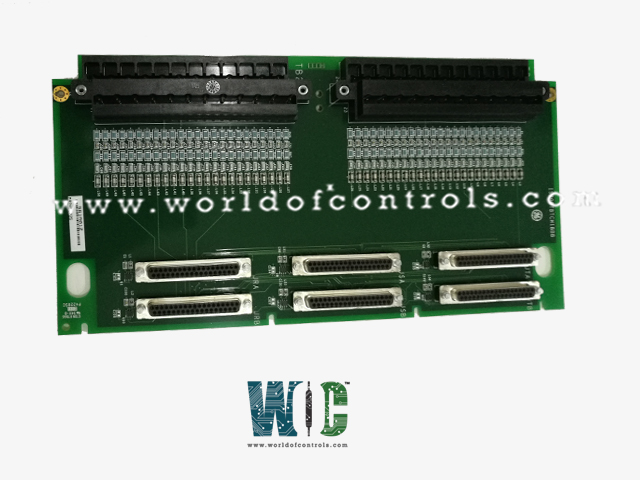
World Of Controls understands the criticality of your requirement and works towards reducing the lead time as much as possible.
IS200TBTCS1B - Thermocouple Input Terminal Board is available in stock which ships the same day.
IS200TBTCS1B - Thermocouple Input Terminal Board comes in UNUSED as well as REBUILT condition.
To avail our best deals for IS200TBTCS1B - Thermocouple Input Terminal Board, contact us and we will get back to you within 24 hours.
SPECIFICATIONS:
Part Number: IS200TBTCS1B
Manufacturer: General Electric
Series: Mark VI
Product Type: Thermocouple Input Terminal Board
Number of channels: 24
Thermocouple Types: E, J, K, S, T
Span: -8 mV to +45 mV
Power supply voltage: 28 V DC
Voltage Range: 18 - 32 VDC
Mounting: DIN-rail mounting
Technology: Surface mount
Operating temperature: -25 to 70°C
Size: 33.02 cm high x 17.8 cm
Repair: 3-7 days
Availability: In Stock
Country of Origin: United States
Manual: GEH-6153
FUNCTIONAL DESCRIPTION:
IS200TBTCS1B is a Thermocouple Input Terminal Board manufactured and designed by General Electric as part of the Mark VI Series used in GE Speedtronic Gas Turbine Control Systems. Thermocouple inputs of the 24-type E, J, K, S, or T are supported by the Thermocouple Input (TBTC) terminal board. Only when combined with PTCCH2 in Mark VIe does it accept extra inputs from B, N, and R types of thermocouples. Wiring connects two barrier-type blocks on the terminal board to these inputs. Using DC variety connectors, TBTC interfaces with the I/O processor. TBTC collaborates with the VTCC processor and supports simplex and TMR applications in the Mark VI system. Two cables link one TBTCH1C to the VTCC. TBTCH1B is connected to three VTCC boards in TMR systems using six connections. The TBTC is available in the following two varieties:
INSTALLATION:
The two I/O terminal blocks should receive the thermocouple wires directly. Two screws are used to secure these detachable blocks to the terminal board where they are placed. Each block has 24 terminals that can accommodate wires up to #12 AWG. Each terminal block has a shield terminal strip that is connected to the chassis ground. In Mark VI systems, cable the TBTC J-type connectors to the I/O processors in the VME rack.
OPERATION:
There are two grounding options for the 24 thermocouple inputs. The distance they can be from the turbine control panel is up to 300 m (984 ft), and the maximum two-way cable resistance is 450. As seen in the following graphic, TBTC includes two CJ reference devices and high-frequency noise reduction. For each type of thermocouple, the analog-to-digital conversion and linearization are carried out by the I/O processor. One VTCC is utilized in Mark VI simplex systems that use TBTCH1C. Two PTCC packs plug into TBTC in Mark VIe simplex systems to obtain 24 thermocouple inputs.
WOC has the largest stock of OEM Replacement Parts for GE Speedtronic Control Systems. We can also repair your faulty boards and supply unused and rebuilt boards backed up with a warranty. Our team of experts is available around the clock to support your OEM needs. Our team of experts at WOC is happy to assist you with any of your automation requirements. For pricing and availability on any parts and repairs, kindly contact our team by phone or email.
What types of thermocouples can be connected to a terminal board?
Most thermocouple input terminal boards support a wide range of thermocouple types, including Type J, K, T, E, N, R, S, and B. The board’s compatibility with these types depends on its design and the data acquisition system it’s connected to. Type K and Type J thermocouples are among the most commonly supported due to their widespread use in industrial applications. The selection of thermocouple type typically depends on the temperature range and environmental conditions of the application.
How many thermocouples can be connected to a single terminal board?
The number of thermocouples that can be connected to a terminal board depends on the board’s design. Standard TITBs may offer 8, 16, or 24 input channels, although some specialized boards can support even more. High-density boards are used when space is limited or when many temperature measurement points are required. The actual number of connections also depends on the size of the board and whether it’s designed for single-ended or differential measurements.
How is channel-to-channel isolation implemented in high-density thermocouple input terminal boards?
In high-density configurations, electrical isolation is crucial to prevent crosstalk, ground loops, and transient propagation. TITBs typically do not provide active isolation themselves but are used with analog input modules that feature channel-to-channel isolation using opto-isolators, isolation amplifiers, or transformer coupling.